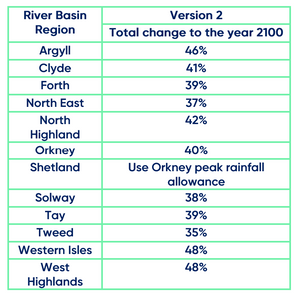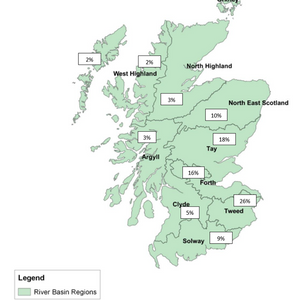SEPA Climate Change Allowances in Scotland
Revised Climate Change Estimates in Scotland River Basins
In April 2024, SEPA updated their guidance with regard to peak flow and rainfall estimates and the additional allowance to account for climate change.
Coastal allowances are unchanged from the previous guidance.
Up until 2018, SEPA required a universal 20% allowance to account for climate change before the publication of Version 1 of the “Climate Change Allowances for Flood Risk Assessment in Land Use Planning” document.
You can find a link to the Word document on the SEPA website.
Version 2 of the document now includes revisions to the impacts of climate change on both river flow and rainfall, based on the latest UK Climate Projections 2018 for Flood Risk Assessments in Scotland.
This latest guidance document includes climate change projections up to the year 2100 and the predicted impact to both river flows and total rainfall – for the 12 River Basin Regions in Scotland.
The required allowance for climate change for peak river flow estimates are presented below, with an average increase of 9% across all regions. This allowance must be accounted for all peak river flow estimates that have:
-
Catchment areas greater than 50km2 (excluding catchments in Orkney and Shetland) and;
-
Catchment areas (excluding Orkney and Shetland) between 30km2 – 50km2 where the peak river flow uplift is larger than the flow increase.
The Tweed River Basin (which previously required a 33% additional allowance for river flows due to climate change), now requires a 59% increase, the largest value to rise with this recent update.
What Are The Revised Climate Change Allowances?
Here are the revised percentage changes by catchment, compared to version 1 of the guidance.

For:
-
River catchments that are smaller than 30km2;
-
River catchments (excluding those in Orkney and Shetland) between 30km2 and 50km2 where the peak river flow uplift is smaller than the peak rainfall intensity allowance;
-
River catchments of any size in Orkney and Shetland and;
-
Issues regarding surface water flooding
SEPA recommends that the following peak rainfall intensities are applied for the River Basins for Scotland.

This new guidance is due to take effect from the 1st of May, so if you’d like to discuss the impact on your project or proposal with regard to flood risk in Scotland and the implications of climate change, please feel free to get in touch with our Scotland Lead Douglas Swinbanks on douglas@aegaea.com or 0131 380 7224.
Total change in each basin in terms of Peak Flow Requirements

Request your free, expert quote now
Aegaea work alongside home owners, private developers, planning consultants, architects, local authorities, international development agencies and contractors. Aegaea know exactly how to help you.